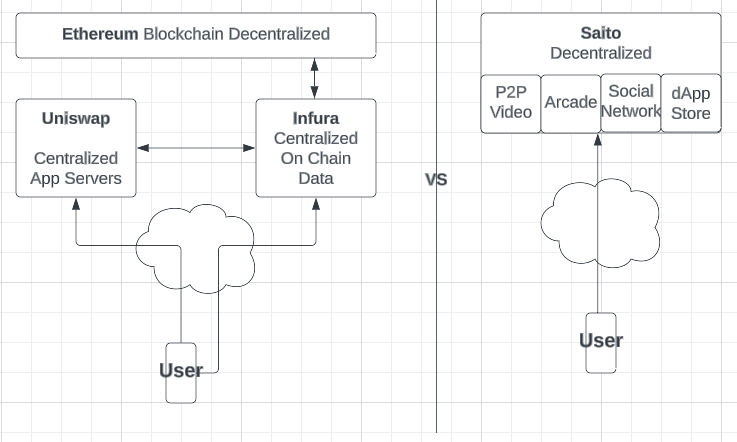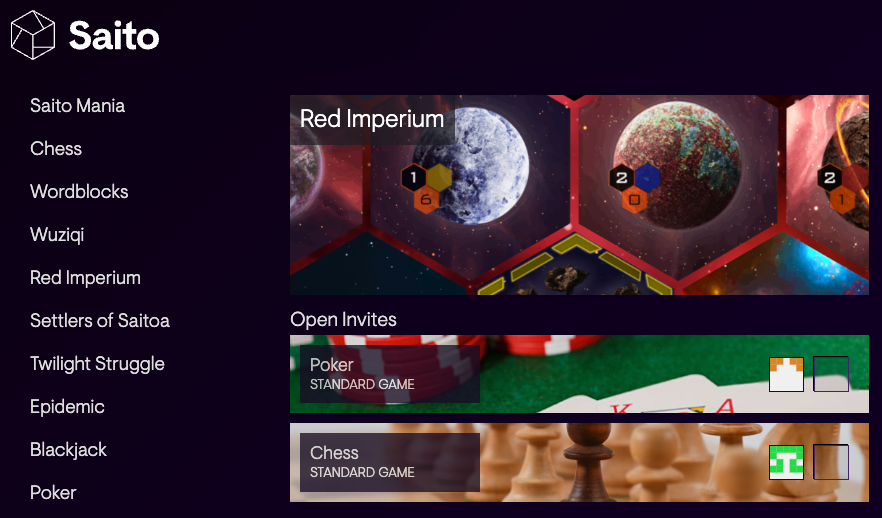Saito is a layer-1 blockchain that provides the foundation for building open and scalable web applications. Saito Consensus maintains openness even at a massive scale, so developers can build great web 3.0 apps for everyone.
Saito Is Scalable
Saito Network is a new blockchain platform that is designed to be faster, more efficient, and more scalable than other blockchains.
We believe the practical limit for a Saito blockchain today is in the order of 100 TB of data per day, and advances in routing capacity will push us to the petabyte level within a decade.
https://saito.io/saito-whitepaper.pdf
It achieves this through a number of innovative features, including:
- On-chain state channels: On-chain state channels are a way of reducing the need for block mining. Instead of every transaction being recorded on the blockchain, transactions are first sent through a state channel between two parties. Once the transaction is complete, it is then broadcast to the blockchain. This reduces the number of transactions that need to be mined, which makes transactions faster and cheaper.
- Proof of stake consensus: Proof of stake is a consensus mechanism that allows for more decentralized governance. In a proof of stake system, nodes are chosen to validate transactions based on the amount of tokens they hold. This means that nodes cannot be controlled by a small number of entities, which makes the network more secure.
- Scalable architecture: Saito Network is designed to be scalable to millions of transactions per second. This is achieved through a number of architectural features, such as sharding and parallelization. Sharding divides the network into smaller shards, each of which can process transactions independently. Parallelization allows for multiple transactions to be processed at the same time. This combination of features allows Saito Network to handle a high volume of transactions without sacrificing speed or scalability.
As a result of these features, Saito Network is well-positioned to become the leading blockchain platform for the next generation of decentralized applications.
How Saito Consensus Works
Saito Consensus is a unique consensus mechanism that is designed to be both scalable and secure. Saito Consensus achieves scalability by using a combination of proof-of-stake and proof-of-work. Proof-of-stake is used to secure the network and proof-of-work is used to scale the network.
Saito Consensus is also designed to be secure. Saito Consensus uses a variety of security features, including:
- Byzantine Fault Tolerance: Byzantine Fault Tolerance is a mechanism that ensures that the network can continue to function even if a small number of nodes are Byzantine. Byzantine nodes are nodes that are malicious or have failed.
- Stake-weighted voting: Stake-weighted voting is a mechanism that ensures that nodes with more stake have more voting power. This helps to prevent the network from being controlled by a small number of nodes.
- Slashing: Slashing is a mechanism that penalizes nodes that misbehave. This helps to deter bad behavior and keep the network secure.
Solving the Infura Problem
Infura is a centralized service that provides developers with access to Ethereum nodes. Infura is a convenient service, but it is also a centralized service. This means that Infura can censor developers and applications.
Saito solves the Infura problem by providing developers with a decentralized way to access nodes. Saito nodes are run by the community, which means that developers can be sure that their applications will not be censored.

Building Dapps in Any Language
Saito is a Turing-complete blockchain, which means that developers can build dapps in any language. This is in contrast to other blockchains, which are often limited to a specific language.
The ability to build dapps in any language makes Saito more accessible to developers. This is because developers can use the language that they are most comfortable with.
Running a Node
Anyone can run a Saito node. Running a node is a great way to support the Saito network and earn rewards.
To run a Saito node, you will need a computer with at least 2GB of RAM. You will also need to download the Saito software and configure your node.
Once your node is running, you will be able to earn rewards by staking Saito tokens. Staking is a process of locking up Saito tokens in order to secure the network.
Sample dApps
Saito has a number of sample apps that are available for developers to use. These apps demonstrate the capabilities of Saito and can be used as a starting point for developers who are building their own dapps.
The sample apps include:
- Red Square: Red Square is a simple chat app that demonstrates the ability of Saito to support real-time social communication.
https://saito.io/redsquare - P2P Call: P2P Call is a voice chat app that shows off the ability to support high-quality audio on Saitoo.
https://saito.io/videocall - Arcade: This is an arcade full of simple games that demos the ability to support gaming applications.
https://saito.io/arcade

Saito Tokenomics
The Saito is a utility token (SAITO) that is used to pay for network fees, secure the network, and participate in governance.
The total supply of SAITO is 21 billion tokens. Of this, 10 billion tokens were sold in an initial coin offering (ICO) in 2018, and 11 billion tokens will be mined over the course of 20 years.
SAITO tokens are used to pay for network fees. These fees are used to secure the network and reward miners for their work. SAITO tokens can also be used to participate in governance. This means that token holders can vote on important decisions that affect the future of the Saito network.
The Saito token is designed to be a deflationary asset. This means that the number of SAITO tokens in circulation will decrease over time. This is achieved through a process called burning. When SAITO tokens are used to pay for network fees, they are burned, which means that they are permanently removed from circulation.
The Saito tokenomics are designed to incentivize users to hold SAITO tokens and participate in the network. This will help to secure the network and ensure its long-term success.
Conclusion
Saito is a promising new blockchain that has the potential to revolutionize the way that dapps are built and used. Saito’s unique features, such as its scalability, security, and decentralization, make it a compelling platform for developers who are looking to build the next generation of web applications.
Saito Links
https://saito.io/
https://saito.io/saito-whitepaper.pdf
https://wiki.saito.io/
https://github.com/0xluminous/awesome-saito#applications
https://discord.com/invite/HjTFh9Tfec
https://coinmarketcap.com/currencies/saito/
https://www.coingecko.com/en/coins/saito


